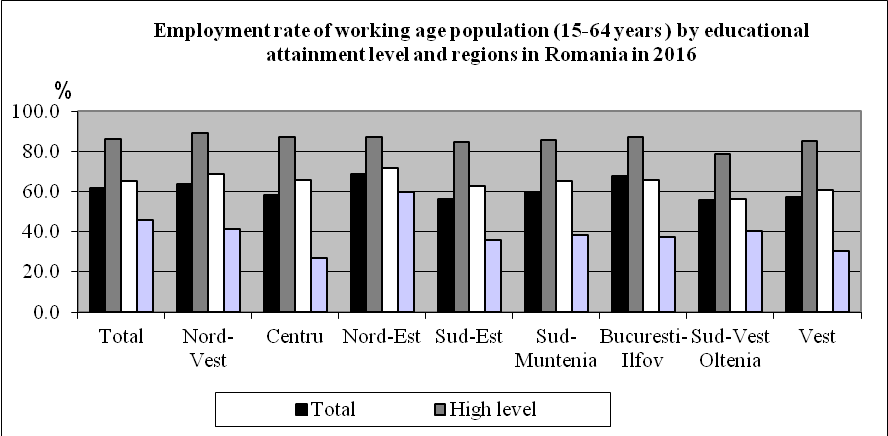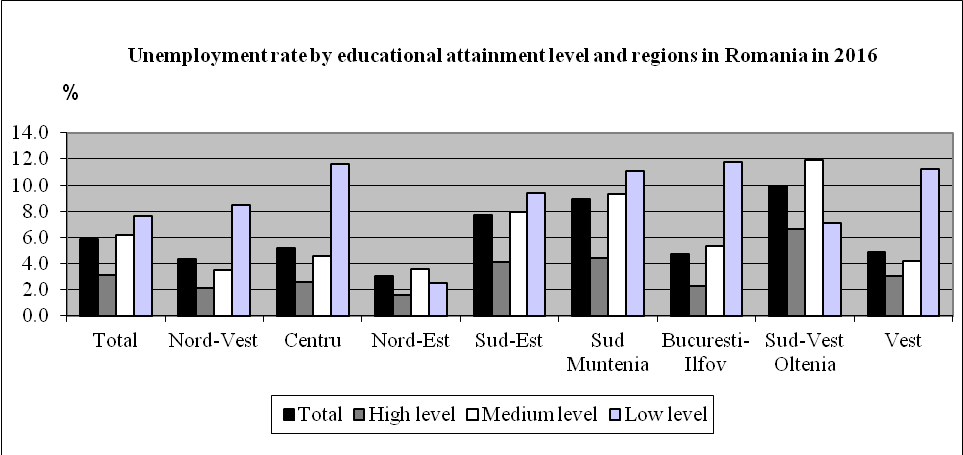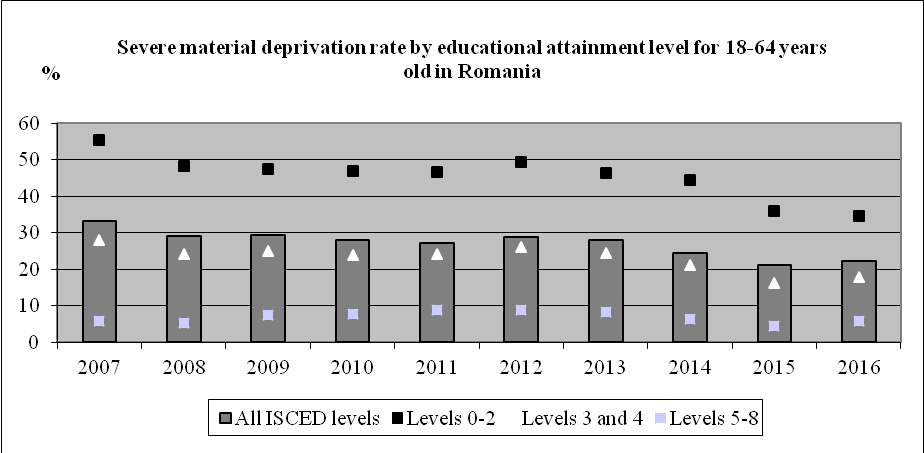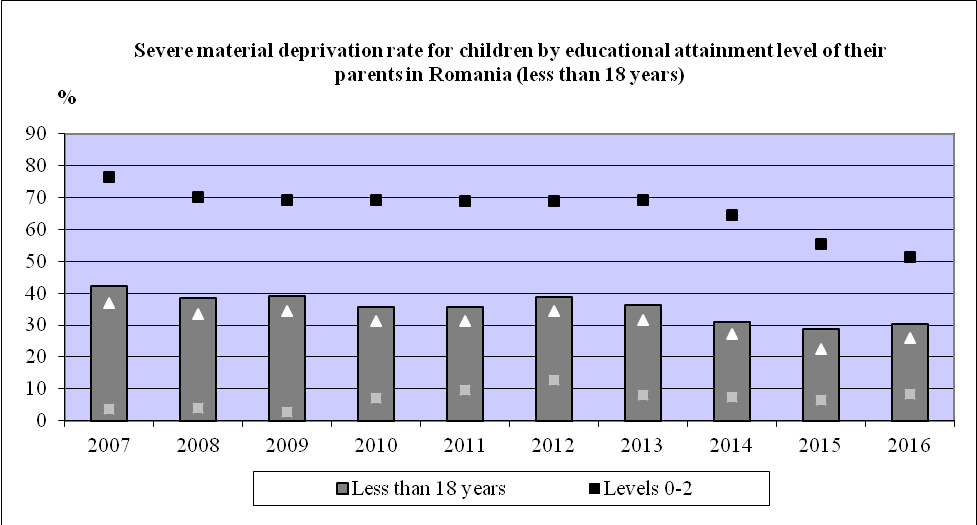Abstract
Parallel to the superior capitalization of material resources, it is necessary to capitalize on human capital in order to generate in the social production a high economic and social efficiency. Therefore, in the European context, the relevance and quality of education and training constitutes a key issue in the policy agenda. The challenge is all the more extensive in the Romanian national space, as the demographic decline and the narrowing of the school age population in the 2030 and 2060 horizons have exercised a great deal of pressure on the human factor. Its qualitative dimension, productivity and efficiency must compensate for the negative effects induced by the quantitative dimension. Demographic challenges are compounded by the increased demands of rapid technological change driven by globalization. Thus, changing occupation type and changing occupational standards and knowledge content at the work place requires a changing education standard. Formal education and training must provide basic skills, knowledge, competences, including specific skills, adaptability, but also to shape the character, behavior and attitude. The graduation degree, the phenomenon of school dropout, the equipping of schools and their connection to the Internet are the main performance indicators of the national education system. As main qualitative targets, we propose eliminating the phenomenon of school dropout, but also the generalization of upper secondary schooling and vocational education, compatible objectives with the 21st century economy and society. The emphasized differentiation of employment and unemployment rates by education level on total country and on the regional level validates its largely protecting role on the labor market.
Keywords: Basic educationskillsdropoutemploymentunemployment
Introduction
Material and spiritual welfare based on economic efficiency, but also on equity and social solidarity are finally the ultimate goal of social construction in our social market economy. But social equity can not exist outside of economic efficiency. This
From the same educational perspective, in the European space, another very high-risk group were youth, due to the lack of first job experience, but also because they are frequently employed on a temporary basis. An exacerbated level of youth unemployment has especially been recorded by southern European countries, in the conditions of this segmentation of the labor market, but especially due to the existence of suboptimal education systems, which once again confirms its determinant role..
Problem Statement
We intend to identify the extent to which the national education system and its performance support favorable developments on the labor market, as a quantitative dimension of a superior capitalization of human capital, indispensable condition of a satisfactory level of economic and social efficiency.
The capitalization of human capital must acquire new dimensions under the pressure exercised by demographic shift and rapid technological change.
For Romania the demographic shift refers to both the aging of the population, regarding the working age and an already installed demographic decline, resulting from the negative rate of natural population growth and external migration.
The technological change and rapid diffusion of the new technologies, driven by globalization, constitutes another challenge of maximum impact. The imperative, as a consequence, is that all occupied persons must prove maximum receptivity, curiosity, creativity and permanent adaptability.
Both challenges generate new and increased standards in terms of a new and better human resource management. We consider that, on the one hand, leadership needs a new approach in managing a work force with a different age structure from what has existed so far. On the other hand, in the organization of work it requires the emergence of new forms, such as intergenerational work and learning-teams, within which older people can capitalize on their own experience and the contribution of young people can take on the form of spontaneity, creativity and the ability to find solutions to new problems.
Research Questions
The national education system is currently characterized by the existence of the following forms: pre-school education, primary and secondary education completed by tertiary and vocational one. Students with the highest performance in education complete their professional training by attending university courses.
The distribution on branches of secondary education (in the school year 2014-2015) we had considered it adequate, respectively 46.8% of the students attended the theoretical course; 46.3% the technological branch and 6.9% the vocational one. We can’t state the same thing about the distribution on different profiles of the technological branch, namely: 47% of the students attended the technical profile and 35.9% the services profile. According to the country's economic potential and the contribution of different sectors to creating added value, we consider that the agricultural profile of the technological branch should be one well represented.
The fact that starting with this year has been initiated a three-year educational program that allows for registration in vocational education after gymnasium we consider it salutary. The segment of the pupils who will not follow either the theoretical or technological branch of secondary education will attend this training program that can provide solid foundation for practicing a job on the labor market, so that these young people will not be outsiders
The access to education does not raise problems,
The school performance from the prism of graduation (98.5% in primary education, 95.2% in gymnasium and 96.2% in secondary education) we consider it adequate, the proportion of failed pupils isn’t significant.
Worrisome, we believe that it should be, from the perspective of performance, the option of some Olympic students with brilliant results at international competitions to attend the courses of prestigious universities abroad.
A present negative phenomenon, worrisome from the perspective of the current and especially future labor market demands, is school dropout. This represented 1.8% in primary education, 2.1% in gymnasium and even 3.5% in secondary and vocational education, negatively marking the performance of the system.
From the perspective of the strategic guidelines, in the Strategy dedicated to the field for the next 20 years, elaborated within the Romanian Academy, were identified in an inspired manner the coordinates of authentic learning. Thus, the start in education must be compulsory a good one to model curious, creative minds in "open schools and universities" through "excellence in teaching" and the utmost involvement of both teachers and pupils/students. The effects will be certain: efficiency in the economic practice, welfare from social perspective and, last but not least, self-esteem from the perspective of personal development.
The representatives of the academic environment highlight the following pillars developed through education as Jacques Delors mentions: learning to know; learning to do; learning to live with others and learning to exist. The whole social system must support this demarche with a suitable start in the educational process and an effective finality in the economy and society, finally in the existential plan. The benefits go beyond the sphere of the economy and the labor market,
This whole education demarche in the conditions of knowledge based society mandatory requires being complemented with lifelong learning, with further training, on-the-job training, already extensive practice in the European space, but not equal in all countries. Romania is among those European countries that have to increase their efforts in developing effective training partnerships with the involvement of educational entities and various employers in order to ensure the capitalization of local potential and resources, traditions, taking into account the specific cultural dimension and the permanent need for the workforce to maintain, update knowledge and acquire new ones..
Purpose of the Study
The raising awareness of all responsible factors at national level, concerning the complex role which has in economy and society, the investment in education, but also improving the general perception on it, as a determinant input for both economic and social efficiency.
The role of knowledge and skills acquired through education in support of the economic efficiency no longer needs arguments. Certainly, the workers who will be employable will only be the productive and competitive ones.
Education contributes decisively not only to the satisfaction of the requirements arising from the economic dimension of development but also from the social dimension. Economic efficiency also creates space for efficient management of social policy. Only receptive, adaptable and responsible individuals may be a voice that firmly states social equity.
Research Methods
We had proposed the investigation of relevant paper and strategies on this topic, existing on a national and European level, but also of the statistical database of the National Institute of Statistics and EUROSTAT for the selection of the most appropriate indicators of analysis.
The main indicators that characterize integration into the labor market, respectively, employment and unemployment rates are in a great extent differentiated according to the level of education. Thus, statistical data validates our intuition, namely that the lack of education constitutes a major obstacle into professional insertion.
Even if, in contemporary society the profession and career are source of personal satisfaction and fulfillment, they must be completed with a satisfactory level of welfare. Also from this perspective, the statistical data are particularly suggestive: the level of education constitutes in its turn a determinant input for poverty differentiation.
Findings
The educational attainment level significantly differentiates employment and unemployment level. With the increase of education level the employment rate is increasing and the unemployment rate is declining.

Source: Labor force employment and unemployment, INS
The chart shows the most recent values of employment rates by education level on regional profile. Naturally, the lowest employment rates are recorded for the low education level. The deviation from this characteristic in the South-West Oltenia and North-East region respectively, for the low level of education a high employment rate should be associated in interpretation with the values of employment rates registered by residence (urban/rural): a very low employment rate in urban areas and a high employment rate in rural areas. The high values of employment rates recorded in the rural environment are considered to be interpreted on the account of employment in an agriculture marked by structural rigidities: fragmentation of agricultural areas with many inefficient small holdings; extensive agricultural areas still un-irrigated and in some cases inadequate mechanization of agricultural works. All this has led to inefficient and insufficiently market-oriented subsistence agriculture. Such a rural employment does not bring enough revenue for the rural population and ensures only a poor rural development as a whole.
Full of significance for the theme of our paper work is the structure of the employed population according to the level of education: from 8,448,777 persons employed 20.55% have higher education level; 58.9% have medium education and 20.46% have low education level. Our opinion is that the redistribution from the low level of education to the medium level of education is mandatory, which is validated by the employment precariousness especially in rural areas. Thus, out of the 1,728,835 persons with low education, in proportion of 78.70% are found in the rural area and about 50% of them are unpaid family workers in the mentioned subsistence agriculture.

Source: Labor force employment and unemployment, INS
The risk of unemployment has fully manifested among low-educated people, but in some regions such as South-West Oltenia, South Muntenia and South-East unemployment rates also have been increased for people with a medium level of education that eventually constitutes the mass phenomenon in the employed labor force but also correlated with the restructuring in the economy.
The level of education represents a major characteristic of the current employment model, as well as of the differentiation of the poverty status of the population. This social reality is reflected by more indicators of poverty. However, we have opted for the "severe material deprivation rate" indicator, which the economic literature recommends as an indicator that measures with fidelity the poverty status of the population.
The selected analysis period is 2007-2016, 2007 being the year of Romania's adhesion to the EU and at the same time the pre-crisis year and 2016 offers the latest available data.
During this time period, there is a huge gap between the values of the indicator according to the education level (fig.3).
The state of material deprivation of the population respectively, of households has engendered the phenomenon of child poverty in Romania, but also in European context, a serious and worrisome phenomenon, through the consequences that can generate throughout adult life: in the form of the access to education and consequently, of future integration into work and society, finally in the form of the impact on the general health state.
For the children and young minors (less than 18 years old), an extremely differentiated rate of severe material deprivation has been registered in Romania by educational attainment level of their parents. In the pre-crisis year 2007, the values of this indicator were 76.5% for children and young people whose parents had low levels of education, 36.8% for the medium level of education and only 3.6% for higher education. The EU average correspondent level, of poverty was much more attenuated respectively, 23.6%, 11.3% and 2%. Not just the magnitude of poverty is serious and worrisome, but also its persistence over time: it has eroded to some extent, but its level remained high (fig.4).

Source: EUROSTAT

Source: EUROSTAT
Together with jobless households, low-work intensity households, temporary workers, low educated people are equally a severely affected poverty target group. The fact that the values of the indicator we selected for the analysis in the case of higher education level of the parents have increased from 3.6% in 2007 to 12.9% in the context of the crisis and remained at a sufficiently high level of 8, 5% in the year 2016 indicates the fact that the protective role of education on the labor market as well as in terms of welfare derived from work has been to some extent eroded by crisis as some analyzes of labor market developments indicate.
Conclusion
We propose a substantial improvement in the performance of the national education system by eliminating the phenomenon of school dropout and generalizing upper secondary schooling and vocational education as compatible objectives with the 21st century economy and society.
For the latter, namely upper secondary education, its structure on branches should be rigorously grounded in accordance with the structure of economic activity and of the GAV (gross added value) in the regional profile.
From the same perspective, of the factors that support the performance, we appreciate that student to teacher stuff ratio is an appropriate one in the Romanian educational system and otherwise we don’t consider this ratio than as a favorable condition of the educational performance but not a decisive one. A determinant factor is the privilege of the pupil-tutor relationship that needs to know the pupil's potential but also his/her socio-economic background, so that, in particular, for pupils from disadvantaged backgrounds can intervene with personalized support measures. This is the real way to support intergenerational mobility in education, which is the real foundation for further occupational and social mobility. In our opinion, this is the way for achieving real social inclusion and easier and more effective management of social policy.
We also suggest continuous monitoring of developments that characterize the education performance-labor market developments link.
References
- Academia Română, Prof. Univ. Ioan Dumitrache, M.C.A.R., Prof. Univ. Mircea Dumitru, M.C.A.R.- Ministrul Educaţiei, Acad. Emil Burzo, Acad. Ioan-Aurel Pop (coordonatori), Şcoala şi educaţia în viziunea Academiei Române. România Educată – RE TOP 10, în Strategia de Dezvoltare a României în următorii 20 de ani, Volumul III, Partea a 2-a, coordonator Acad. Ionel-Valentin Vlad Preşedintele Academiei Române, Editura Academiei Române 2016, ISBN 978-973-27-2737-9, paginile 1-38.
- Bussi, M., (ETUI), Quality education for quality jobs, Final Report, Contract VP/2011/07, European Trade Union Confederation (ETUC), 2012.
- CEDEFOP, The dynamics of qualifications: defining and renewing occupational and educational standards, Luxemburg: Office for Official Publications of the European Communities, ISBN 978-92-896-0605-9, ISSN 1562-6180, 2009.
- Eichhorst, W., Hinte, H., Rinne, U., Youth Unemployment in Europe: What to do about it ?, IZA Policy Paper No 65, Forschunginstitut zur Zukunft der Arbeit, Bonn, 2013
- INS, Mihaela Anghel, Gabriela Asimina Deacu, Antoaneta-Tamara Cîrlig, Alin-Doru Cotîrţă, Irina Necşescu, Elena-Sultana Stan, Cristina-Andreea Mănescu, Ana-Maria Cristea, Bogdan Greabu, Coordonatorul publicaţiei Elena Mihaela Iagăr, Coordonatorii ediţiei, Silvia Pisică, Lavinia Elena Bălteanu, Sistemul educaţional în România – Date Sintetice, Anul şcolar/universitar 2014-2015, INS 2016, ISSN: 2067-2187, ISSN-L: 1584-8477.
- INS, Sanda Nedelcu, Monica Apostol, Bogdan Greabu, Diana Popa, Mirela Ioniţă, Coordonatorul publicaţiei Elena Mihaela Iagăr, Coordonatorii ediţiei, Silvia Pisică, Lavinia Elena Bălteanu, Ruxandra Moldoveanu, Forţa de muncă în România. Ocupare şi şomaj în anul 2016, INS 2017, Editura Institutului de Statistică, ISSN 1842-3124, ISSN-L 1223-6446.
- International Labour Office, A Skilled Workforce for Strong, Sustainable and Balanced Growth: A G20 Training Strategy, ILO-Geneva, 2010, ISBN 978-92-2124278-9, 2011.
- Janta, B., Ratzmann, N., Ghez, J., Khodyakov, D., Yaqub, O., Employment and the Changing labour market, Global societal trends to 2030: Thematic report 5, RAND Europe, RAND Corporation, Santa Monica, Calif., Cambridge, UK, 2015.
- Ludemann, E., Richter, B., Youth Unemployment in Southern Europe-Result of the crisis or a flaw in the system?, KFW Economic Research No 43, 2014.
- OECD (2016), Education at a Glance: OECD Indicators, OECD Publishing, Paris, ISBN (PDF) 978-92-64-25980-5, http://dx.doi.org/10.197/eag-2016-en
Copyright information

This work is licensed under a Creative Commons Attribution-NonCommercial-NoDerivatives 4.0 International License.
About this article
Publication Date
16 October 2017
Article Doi
eBook ISBN
978-1-80296-030-3
Publisher
Future Academy
Volume
31
Print ISBN (optional)
-
Edition Number
1st Edition
Pages
1-1026
Subjects
Education, educational psychology, counselling psychology
Cite this article as:
Livia, C., & Cristiana, T. A. (2017). Education And Training In The Service Of The Labour Market In Romania. In Z. Bekirogullari, M. Y. Minas, & R. X. Thambusamy (Eds.), ICEEPSY 2017: Education and Educational Psychology, vol 31. European Proceedings of Social and Behavioural Sciences (pp. 678-686). Future Academy. https://doi.org/10.15405/epsbs.2017.10.65

